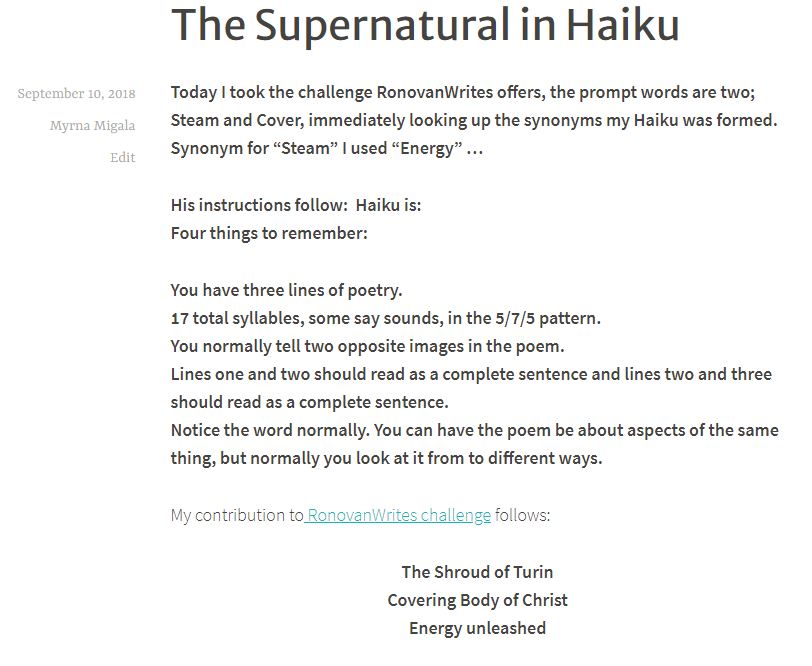Fantango‘s Flashback several year, I had to time travel to find one from Sept. 10th.
Notice the date from September 10, 2018

I wonder if I’ve improved since then? I wonder?
Notice the date from September 10, 2018

I wonder if I’ve improved since then? I wonder?
Today I took the challenge RonovanWrites offers, the prompt words are two; Steam and Cover, immediately looking up the synonyms my Haiku was formed. Synonym for “Steam” I used “Energy” …
His instructions follow: Haiku is:
Four things to remember:
You have three lines of poetry.
17 total syllables, some say sounds, in the 5/7/5 pattern.
You normally tell two opposite images in the poem.
Lines one and two should read as a complete sentence and lines two and three should read as a complete sentence.
Notice the word normally. You can have the poem be about aspects of the same thing, but normally you look at it from to different ways.
My contribution to RonovanWrites challenge follows:
The Shroud of Turin
Covering Body of Christ
Energy unleashed
It is my opinion that this relic left for our time now that technology is better advanced compared to past centuries.
Going back in time a little to the year 1898; according to Wiki an Italian lawyer and amateur photographer by the named Secondo Pia a man known for taking the first photographs of the Shroud of Turin. While developing them, noticing that the photographic negatives showed a more precise rendition of the image. He said he almost dropped and broke the photographic plate in the darkroom from the shock of what appeared on it: the reverse plate showed the picture of a man and a face that was not visible with the naked eye. Furthermore, when the negative was developed, it showed a positive image of a human face. He concluded that the image itself was, therefore, in effect, a photographic negative.
How could this then be a medieval forgery?
Again in 1931 when a professional photographer, Giuseppe Enrie, also photographed the shroud and his findings supported Pia.
Now we know it was not a painting at all.
Recently some very interesting information has come to the world about the Shroud of Turin, the burial cloth of Jesus Christ.
Nanoparticles!
Nanoparticles, what are they? Nanoparticles are tiny materials having size ranges from 1 to 100 nm. In this assay at present, are now referred to as particles of blood. Blood particles not typically found in a healthy human. Why? Because these blood particles contain substantial levels of creatinine and ferritin, a substance found in persons who have much suffered much as in torture. Such findings of this type of organic nanoparticles conclude that the person wrapped within this shroud did experience a violent death. Also, this discovery debunks the naysayers claim that the image is
AGAIN somehow painted on the shroud.
Consider also another point about the fabric. The cloth is consistent with materials from first-century Israel, but not with medieval Europe. A forger would have had to not only forge the image but would have had to have detailed knowledge of linen weaves of the first century and then not only reproduce it but age it convincingly.
At this point, the fiber is twisted (spun) into the thread. During Jesus’ time, all spinning was done by hand with spindles. The spinning wheel was not around yet, and the world waited another 500 years for that tool.
In the spinning process, the spinner twists the fibers in one of two ways: clockwise (Z) or counterclockwise (S). Because the structure of the flax fiber has a natural tendency to twist itself in an S twist, spinners over the millennia have spun it in this S direction, as if not wanting to “fight” the fiber. Curiously, the yarn that makes the Shroud was turned in a Z twist (clockwise). In other words, the weave is consistent with the era of Christ.
Just to elaborate a little further on this weave the yarn used to weave the Shroud of Turin is of very high quality, evenly spun, and it has been woven into an unusual, fancy pattern for the time, called 3 to 1 herringbone twill. The resulting cloth is very fine, with a density of about 89 threads per inch.
We read in Mark 15;43-46
“Joseph of Arimathea, a highly regarded member of the council, who was himself looking forward to the kingdom of God, went boldly to Pilate and asked for the body of Jesus. Pilate was surprised that he was already dead. He called the centurion and asked him if he had been dead for some time. When Pilate was informed by the centurion, he gave the body to Joseph. After Joseph bought a linen cloth and took down the body, he wrapped it in the linen and placed it in a tomb cut out of the rock. ”
There was a noise in the media in 1987 when the Shroud was subjected to carbon-14 dating technology which dated it to the 13th century. The fabric of the shroud is linen, not cotton and proven the sample was from a patch with 16th-century cotton some nuns mended near the edge of the shroud.
There is so much more to consider about the authenticity of the Shroud of Turin; many YouTube’s are out there for your ASSAY on this subject.